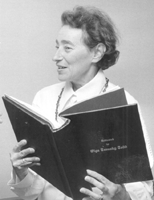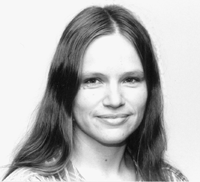Meandering Mathematical Career Paths
January 14, 2000

A career marked by dramatic and often discouraging twists and turns made Olga Taussky Todd (1906-1995) a fitting source of inspiration for an AWM workshop designed to illustrate the many possible forms a successful career in the mathematical sciences can take.
Dianne P. O'Leary
From a distance, it can appear that all successful mathematicians follow simple career paths, striding up the ladder in their chosen university, government laboratory, or industrial environments.
In reality, many successful careers are circuitous, involving changes of course either because of adjustments in the mathematicians' priorities or because of external events. The career of Olga Taussky Todd (1906-1995) is a prime example of the circuitous variety. A saturated job market in Europe, followed by the upheavals of World War II, caused her to begin her career in a series of temporary positions, in some cases unpaid. Nonetheless, she thrived in a number of appointments in both academia and government, in such institutions as G�ttingen, Bryn Mawr, Girton College in Cambridge (a women's college of Cambridge University), the National Physical Laboratory, the National Bureau of Standards, the Institute for Advanced Study in Princeton, and, finally, the California Institute of Technology. Meanwhile, a change in her interests ("I did not look for matrix theory. It somehow looked for me.") led her to de-emphasize her research in number theory.
Even after she was well established, rules against nepotism denied her the academic rank she deserved, although she did not let this obstacle hinder her teaching or her research. Students flocked to her, and she supervised 13 PhD students at Caltech, in addition to the three she had supervised in previous positions. In 1971, after she had been at Caltech for 14 years, her rank was upgraded from research associate to professor, a position she held for about five years, until her mandatory retirement at the age of 70.
Her contributions to the matrix theory literature include key results on diagonal dominance, commutativity, Gershgorin theory, inertia theory, Lyapunov's theorem, and integral matrices and their connection with algebraic number theory. She was a founding editor of the journal Linear Algebra and Its Applications, and she edited the first volume of Hilbert's collected works on number theory.
The Association for Women in Mathematics decided to honor Olga Taussky Todd by organizing a conference in her memory. The Olga Taussky Todd Celebration of Careers in Mathematics for Women, held July 16-18 at the Mathematical Sciences Research Institute in Berkeley, was organized by Bettye Ann Case (Chair), Carolyn Gordon, Gail Ratcliff, Jean Taylor, Sylvia Wiegand, and me. Many of the approximately 140 attendees were graduate students and recent PhDs.
To reflect the diversity of mathematical careers, and to suggest alternatives for young people discouraged by the tight academic job market, we highlighted the plethora of employment opportunities for mathematicians outside the traditional academic track, and the wide variety of career paths that are possible, including mathematics in biology, finance, materials science, information technology, and K-12 education. The speakers were chosen to illustrate some of the lesser-known career paths, especially those involving transitions among academia, government, and industry, and to acquaint the attendees with Taussky Todd's life and work.
Fern Hunt (National Institute of Standards and Technology) began her career with a teaching position at Howard University. She later expanded her one-day-a-week consulting job at NIST (the current name of NBS, one of Taussky Todd's first employers in the U.S.) into a full-time career. Hunt spoke on the daunting task of how to model the weathering of paint as it is exposed to ultraviolet radiation and how to predict its durability based on the microstructure of the pigment particles and polymeric binder.
The career path of Linda Petzold (University of California, Santa Barbara) went in the opposite direction. In an enthusiastically received presentation titled "Math with an Attitude," she discussed a career that began with a software development project in a national lab. From there, she moved to academia, initially to an ill-fitting job and finally to the right match, in a department of mechanical and environmental engineering.

"Math with an Attitude": Linda Petzold (SIAM's newly elected vice president at large) described a career that took her to a national lab and an ill-fitting academic department before she found "the right match," again in academia, in an engineering department.
Three speakers---Lisa Goldberg (BARRA, Inc.), Diane Lambert (Bell Lab-oratories, Lucent Technologies), and Lani Wu (Microsoft)---discussed careers influenced in each case by an unexpected fascination with applications: finan-cial modeling at an investment firm for Goldberg, data mining for Lambert, and a variety of software problems for Wu.
Evelyn Boyd Granville gave an inspiring presentation on a journey that began in 1949, when she became one of the first women in the U.S. to receive a PhD in mathematics (Yale University). She went on to make contributions in academia, government, and industry, and her active involvement in K-12 mathematics education continues today. As opportunities for women and minorities have increased, she pointed out, the pool of bright and qualified K-12 teachers has diminished, with serious implications for the pipeline of women and minorities interested in mathematics. It is worth visiting http://www.agnesscott.edu/lriddle/women/granvill.htm to learn more about her story.
Margaret Wright (Bell Labs) and Cathleen Morawetz (Courant Institute of Mathematical Sciences) both spoke on their transitions from marginal academic jobs to mainstream careers, Wright in industry and Morawetz in academia. Both of these women have combined research with strong commitments to the mathematical community, serving perhaps most visibly as presidents of two of the major U.S. mathematical societies.
Helene Shapiro (Swarthmore), one of Taussky Todd's PhD students, and Christa Binder (Technische Universit�t Wien) gave presentations on Taussky Todd's life and work, and a panel discussion moderated by Mary Ann McLoughlin provided further information. We were pleased to have John Todd in attendance to provide loving remembrances of his wife, and Richard Varga provided other insights on Taussky Todd.
The program was rounded out by panel discussions on finding and keeping a job (organized by Sylvia Wiegand of the University of Nebraska and Krystyna Kuperberg of Auburn University), by research poster presentations by 38 attendees at the beginning of their careers, and by mentoring sessions.
One theme emerged in many of the talks: "When I was in graduate school, I never thought I would be doing what I am doing now!" The speakers' advice to their younger colleagues was to keep their minds open and not stay immersed in small problems. Discussing their roles, whether in teaching, research, or service to the community, they seemed to echo the words of Taussky Todd: "But it seems to me that both in the work of others and in my own I look for beauty, and not only for achievement."
Videos of the major presentations at the conference are available for viewing from the MSRI Web site (http://www.msri.org/) under "videos, MSRI Spring 1999."
Further information can be found in the AWM Newsletter and in the conference proceedings (in preparation). A wonderful source on the life of Olga Taussky Todd is the obituary that appeared in 1996 in the Notices of the AMS (http://www.ams.org/notices/199608/taussky.pdf).
Dianne O'Leary is a professor of computer science at the University of Maryland, College Park.

